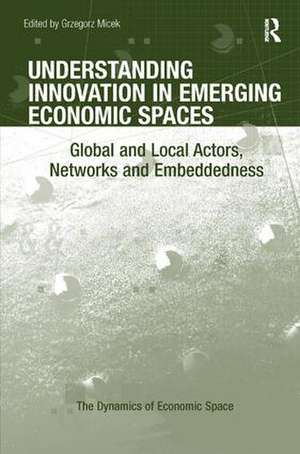Understanding Innovation in Emerging Economic Spaces: Global and Local Actors, Networks and Embeddedness: The Dynamics of Economic Space
Autor Grzegorz Miceken Limba Engleză Hardback – 28 iul 2015
| Toate formatele și edițiile | Preț | Express |
|---|---|---|
| Paperback (1) | 325.34 lei 6-8 săpt. | |
| Taylor & Francis – 5 feb 2018 | 325.34 lei 6-8 săpt. | |
| Hardback (1) | 768.64 lei 6-8 săpt. | |
| Taylor & Francis – 28 iul 2015 | 768.64 lei 6-8 săpt. |
Din seria The Dynamics of Economic Space
-
 Preț: 155.43 lei
Preț: 155.43 lei -
 Preț: 281.86 lei
Preț: 281.86 lei - 9%
 Preț: 1003.43 lei
Preț: 1003.43 lei - 26%
 Preț: 764.62 lei
Preț: 764.62 lei - 13%
 Preț: 338.33 lei
Preț: 338.33 lei -
 Preț: 389.99 lei
Preț: 389.99 lei -
 Preț: 469.34 lei
Preț: 469.34 lei - 13%
 Preț: 337.00 lei
Preț: 337.00 lei -
 Preț: 489.26 lei
Preț: 489.26 lei - 16%
 Preț: 260.33 lei
Preț: 260.33 lei - 12%
 Preț: 325.34 lei
Preț: 325.34 lei - 12%
 Preț: 325.34 lei
Preț: 325.34 lei -
 Preț: 386.18 lei
Preț: 386.18 lei -
 Preț: 389.11 lei
Preț: 389.11 lei - 17%
 Preț: 259.98 lei
Preț: 259.98 lei -
 Preț: 387.20 lei
Preț: 387.20 lei -
 Preț: 352.41 lei
Preț: 352.41 lei -
 Preț: 391.99 lei
Preț: 391.99 lei -
 Preț: 389.11 lei
Preț: 389.11 lei -
 Preț: 389.66 lei
Preț: 389.66 lei - 18%
 Preț: 1000.61 lei
Preț: 1000.61 lei
Preț: 768.64 lei
Preț vechi: 1030.01 lei
-25% Nou
Puncte Express: 1153
Preț estimativ în valută:
147.10€ • 153.38$ • 122.25£
147.10€ • 153.38$ • 122.25£
Carte tipărită la comandă
Livrare economică 20 martie-03 aprilie
Preluare comenzi: 021 569.72.76
Specificații
ISBN-13: 9781472410337
ISBN-10: 1472410335
Pagini: 290
Dimensiuni: 156 x 234 mm
Greutate: 0.7 kg
Ediția:1
Editura: Taylor & Francis
Colecția Routledge
Seria The Dynamics of Economic Space
Locul publicării:Oxford, United Kingdom
ISBN-10: 1472410335
Pagini: 290
Dimensiuni: 156 x 234 mm
Greutate: 0.7 kg
Ediția:1
Editura: Taylor & Francis
Colecția Routledge
Seria The Dynamics of Economic Space
Locul publicării:Oxford, United Kingdom
Cuprins
Contents: Introduction: innovation in emerging economic spaces in the context of the local-global dichotomy, Grzegorz Micek. Part I Introduction: Managing innovation in 'localities of learning' in Berlin and Seville, Sascha Brinkhoff, Lech Suwala and Elmar Kulke; Industrial and R&D activity in emerging economies - Poland versus other EU countries, Tomasz RachwaA' and Krzysztof Wiedermann; Shortcomings and weaknesses in understanding and measuring knowledge interactions, Grzegorz Micek. Part II Large Firms and FDI: Global-Local Dichotomy: Geographical embeddedness of large corporations in Turkey, Aksel Ersoy; Foreign direct investment in Estonia - understanding the impact of public policies on local embeddedness and networking in the food retail and related industries, Egert Juuse, Sylvi Birgit Endresen and Rainer Kattel; Twenty years of restructuring in the Estonian food retail industry - the interplay of the political economy of Estonia and institutional, historical and geographical factors, Egert Juuse, Sylvi Birgit Endresen and Rainer Kattel; The role of local and foreign companies in the development of non-metropolitan rural areas in Poland, Magdalena Dej; Beyond localness: development dimensions of the NiepoA'omice Investment Zone, Wojciech Jarczewski, Maciej Huculak, Magdalena Dej and Auukasz SykaA'a. Part III Innovative Small Firms - Strategies and Behaviour: Beyond a creative class hotspot: innovation in independent and corporate coffee shop enterprises, Mathew Novak; The role of creativity and innovativeness of firm managers in socio-economic development: the case of the PoznaA" Metropolitan Region, MichaA' MA(TM)czyA"ski; The global and the local in the Polish biotechnology industry, Piotr Dawidko; Agricultural tourism farms in Poland: how the farmers improve their businesses - a case study, SA'awomir Dorocki, Anna Irena SzymaA"ska and MaA'gorzata Zdon-Korzeniowska. Index.
Notă biografică
Dr Grzegorz Micek is Lecturer at Jagiellonian University, Poland.
Recenzii
’Recent decades have seen an exciting but somewhat perplexing proliferation of concepts describing innovation processes in space. This volume does an impressive job of evaluating this panoply of concepts and applying them to sectors rarely covered and places rarely visited by existing studies. As a diverse set of methodologically rigorous and richly illustrated studies, it will make an engaging read for students and scholars of innovation.’ Dariusz Wójcik, Oxford University, UK ’While research interest in certain emerging economies is still enormous, scholars' attention with respect to several Central and Eastern European countries has waned considerably. That is one reason why this book, an exception to the trend, is worth reading. The second reason is its topic: an analysis of innovation from various angles in a part of the world which was expected to become highly successful on the basis of the quality of its human capital at the beginning of the transformation in 1989. The third reason is its admitted heterogeneity in terms of its methodological approaches, ranging from pure quantitative analysis to case studies, a mix which can be considered a rare species in today's literature.’ Magdolna Sass, Hungarian Academy of Sciences, Hungary
Descriere
A small number of countries, regions, cities, and localities are powerful gatekeepers and generate the bulk of creative and innovative ideas, while the majority is largely excluded. This book looks at neglected, but emerging innovation centres analysed from various spatial and organizational perspectives; ranging from entire countries and regions to individual firms and small neighbourhoods. Bringing together leading scholars from various disciplines, it examines a variety of economic sectors including biotechnology, agrotourism, and the food retail industry. The authors employ various, often contradictory, concepts, ranging from local buzz and the global pipeline, through an analysis of collective learning processes to geographical embeddedness, using both qualitative and quantitative approaches.
